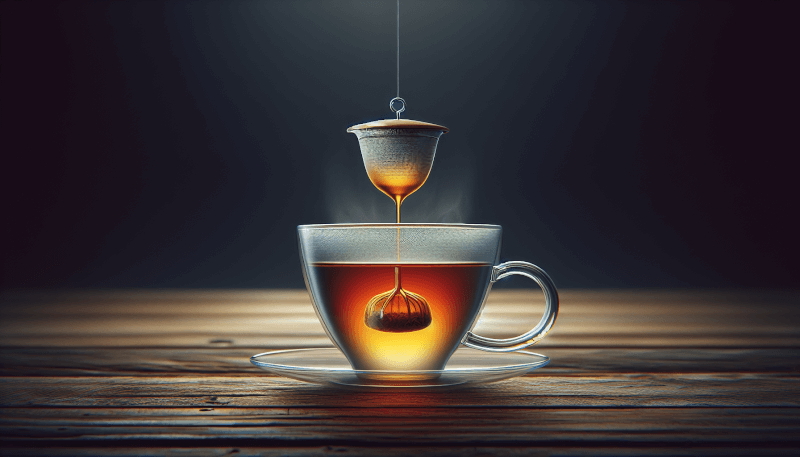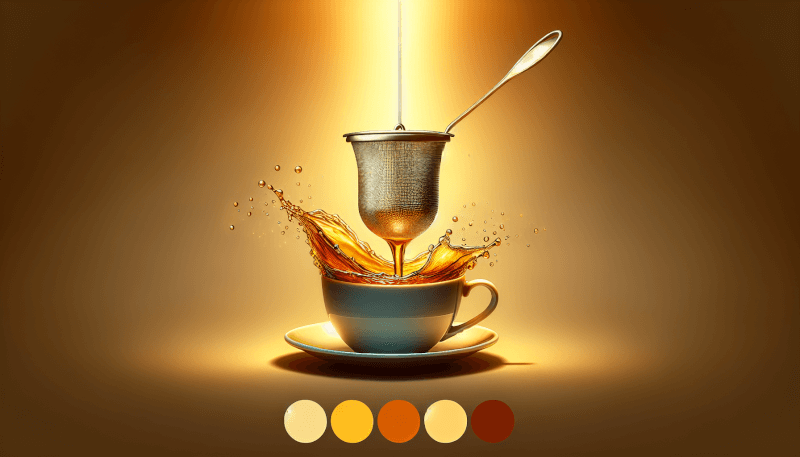You love a good cup of tea, but sometimes it’s a challenge to get it just right. Too weak and the flavor disappears, too strong and it becomes bitter. In this article, we will guide you on how to achieve the ideal tea strength, so you can enjoy a perfectly balanced cup every time. From selecting the right tea leaves to controlling the brewing time, we’ll explore the secrets that will elevate your tea-drinking experience to a whole new level. So grab your favorite mug and get ready to embark on a journey to tea perfection.

Choosing the Right Tea Leaves
When it comes to choosing the right tea leaves, there are a few factors to consider. First, you’ll want to think about the type of tea you prefer. Whether you enjoy black, green, white, or oolong tea, each type has its own unique characteristics and flavor profiles. Take some time to explore the different options and find one that aligns with your taste preferences.
Next, it’s important to identify the caffeine content of the tea. Some individuals may prefer a tea with a higher caffeine content to give them a boost of energy, while others may opt for a caffeine-free option for a more calming beverage. Pay attention to the labeling on the tea packaging or do some research to determine the caffeine levels before making your selection.
Lastly, consider your preferred flavor profile. Are you drawn to floral and light teas, or do you prefer rich and bold flavors? Some teas may have fruity notes, while others may have a more earthy taste. Experiment with different flavors to find the ones that make your taste buds dance with delight.
Determining the Tea-to-Water Ratio
Achieving the perfect tea-to-water ratio is essential for brewing a delightful cup of tea. While there are general guidelines that can be followed, adjusting the ratio based on your personal preference can make all the difference.
In general, a common recommendation is to use one teaspoon of loose tea leaves or one tea bag per cup of water. However, if you prefer a stronger brew, you can add more tea leaves. Conversely, if you enjoy a milder flavor, reducing the amount of tea used may be the way to go. Feel free to experiment with different ratios until you find the perfect balance that suits your taste.
Water Temperature and Tea Brewing
Understanding the optimal temperature for brewing tea is vital in order to extract the best flavors from the leaves. Different types of tea require different water temperatures, so let’s delve into the specifics.
For delicate green and white teas, a lower water temperature of around 160-180°F (70-82°C) is recommended. This preserves the delicate flavors and prevents the tea from becoming bitter. On the other hand, black and herbal teas can withstand higher temperatures, typically around 200-212°F (93-100°C), which helps to fully extract their robust flavors.
While these temperature ranges provide a starting point, don’t be afraid to experiment with slight variations based on your personal preferences. You may find that increasing or decreasing the water temperature by a few degrees enhances the flavors in a way that brings you great joy.
Steeping Time
Steeping time plays a significant role in achieving the ideal tea strength. Following the recommended steeping times ensures that your tea has ample time to infuse, resulting in a flavorful and aromatic cup.
Each type of tea has its own recommended steeping time, which can range from 1-3 minutes for delicate teas like green and white, to 3-5 minutes for black and herbal teas. These guidelines are a great starting point, but they can be adjusted to suit your personal taste preferences.
If you prefer a stronger tea, you can extend the steeping time by a minute or two. Conversely, if you enjoy a milder brew, reducing the steeping time slightly may be the way to go. Remember, the beauty of tea brewing lies in its versatility, so feel free to experiment until you find your perfect brew.

Infusion Techniques
When it comes to infusion techniques, there are a few things to consider. First, you’ll want to decide whether to use tea bags or loose-leaf tea. Tea bags offer convenience and ease of use, while loose-leaf tea allows for a more customizable experience and often results in a superior flavor.
Choosing the right brewing vessel is also important. Whether you opt for a teapot, a French press, or an infuser mug, make sure it suits your preferences and allows for easy straining of the tea leaves. Some vessels are specifically designed for certain types of tea, so consider your favorite tea types when selecting your brewing vessel.
Additionally, don’t be afraid to explore different brewing methods. From traditional methods like gong fu brewing to modern techniques like using a tea infuser bottle, there are countless ways to brew tea. Each method can produce unique flavor profiles and experiences, so have fun experimenting with various techniques to find the ones that resonate with you.
Experimenting with Steeping Methods
Steeping methods can greatly impact the flavors and characteristics of tea, so it’s worth exploring different techniques to expand your tea horizons.
If you typically enjoy hot tea, why not try some hot brewing techniques? For example, you can experiment with multiple short steeps instead of one long steep, which can bring out different flavors and create a more complex cup of tea. Another option is to try cold brewing your tea for a refreshing and smooth flavor profile.
Speaking of cold brew options, steeping tea in cold water overnight is a popular method that results in a naturally sweet and less bitter brew. This technique is particularly well-suited for green and herbal teas, allowing their delicate flavors to shine.
For those seeking a more traditional experience, gong fu brewing is worth exploring. This Chinese tea brewing method involves multiple short steeps and focuses on bringing out the aromatic, nuanced flavors of the tea leaves. Investing in some gong fu brewing tools, such as a clay teapot and small tea cups, can elevate your tea-drinking experience to new heights.

Teaware and Equipment
To enjoy the perfect cup of tea, it’s important to invest in quality tea leaves, as they are the foundation of a delectable brew. Look for reputable tea suppliers that source their leaves from trusted growers, ensuring the highest quality and freshness.
Another essential piece of teaware is a reliable kettle. Look for one that offers precise temperature control, allowing you to heat the water to the optimal temperature for your chosen tea. This will ensure that you extract the best flavors from the leaves and create a consistently satisfying cup of tea.
Lastly, consider finding suitable brewing vessels. Tea pots or infuser mugs with built-in strainers are popular choices, as they make brewing and straining tea a breeze. You may also want to invest in a tea infuser basket or a French press if you prefer loose-leaf tea. Additionally, having a tea cozy or insulated tea cozy can help keep your tea warm for longer periods, allowing you to savor each sip.
Personal Adjustments and Preferences
Ultimately, the perfect cup of tea is a deeply personal experience, and it’s important to consider your own taste preferences when brewing. While following general guidelines and recommendations is a great starting point, don’t be afraid to experiment and make adjustments to suit your desired strength.
Consider trying different tea-to-water ratios, steeping times, and infusion methods until you find the combinations that bring you the most joy. Each person’s palate is unique, so what works for one may not work for another. Embrace the art of tea brewing as a journey of exploration and discovery, allowing yourself the freedom to create your own personalized brew.

Understanding Tea Grades
Tea grades refer to the quality of the tea leaves and are often determined by factors such as leaf size, appearance, and the presence of buds. Familiarizing yourself with tea grading systems can help you make informed choices and select teas that best suit your taste preferences.
In general, higher quality teas often have stronger flavors and more complex profiles. They are typically made from young, tender leaves and buds, resulting in a more delicate and refined taste. Lower-grade teas, while still enjoyable, may have a slightly coarser texture or less pronounced flavors.
Exploring specialty teas can be a thrilling adventure for tea enthusiasts. These teas are often unique in flavor, with characteristics that set them apart from regular teas. From rare and exotic teas like matcha and pu-erh to scented teas like jasmine or Earl Grey, the world of specialty teas offers a rich tapestry of flavors waiting to be explored.
Storing Tea Properly
To preserve the freshness and flavors of your tea, proper storage is key. Tea leaves are sensitive to moisture, sunlight, and strong odors, so it’s important to take precautions to protect them.
First and foremost, ensure that your tea is kept in an airtight container. This will prevent exposure to moisture and help maintain the integrity of the tea leaves. Additionally, store your tea away from direct sunlight, as prolonged exposure can degrade the quality and flavors.
It’s also important to keep tea away from strong odors. Tea leaves have the ability to absorb smells, so storing them in close proximity to spices, herbs, or strongly scented items can affect the overall taste of the tea. Consider dedicating a separate storage area specifically for your tea collection to maintain its purity.
By following these storage guidelines, you can ensure that your tea remains fresh and enjoyable for a longer period of time, allowing you to savor every sip of your favorite brew.
In conclusion, achieving the ideal tea strength is a journey of exploration and personal preference. By considering the tea type, experimenting with steeping methods, investing in quality teaware, and understanding the nuances of tea grading and storage, you can create a tea-drinking experience that is tailored to your taste buds. So go ahead, embrace the world of tea and embark on a delightful adventure to find your perfect cup!



